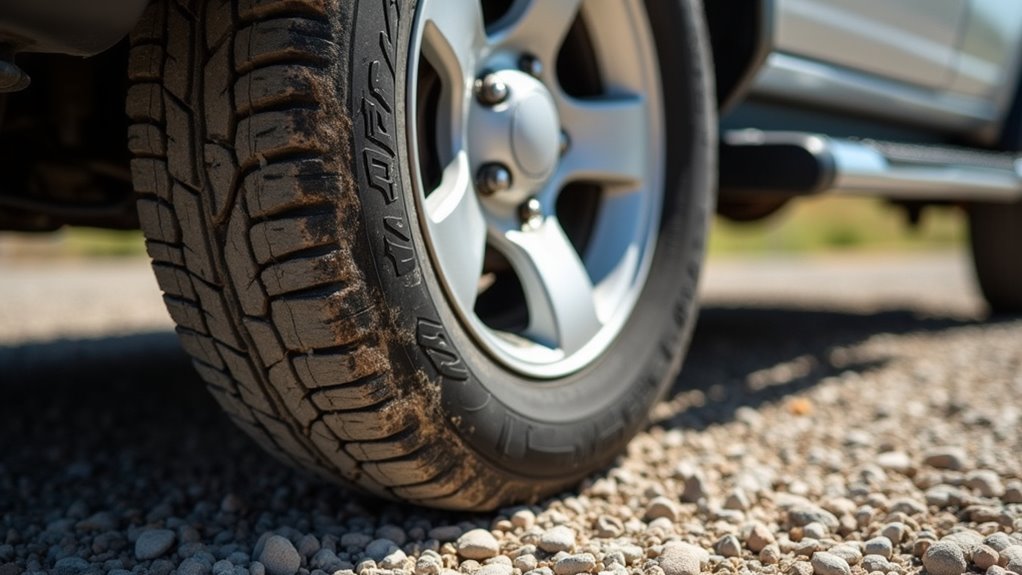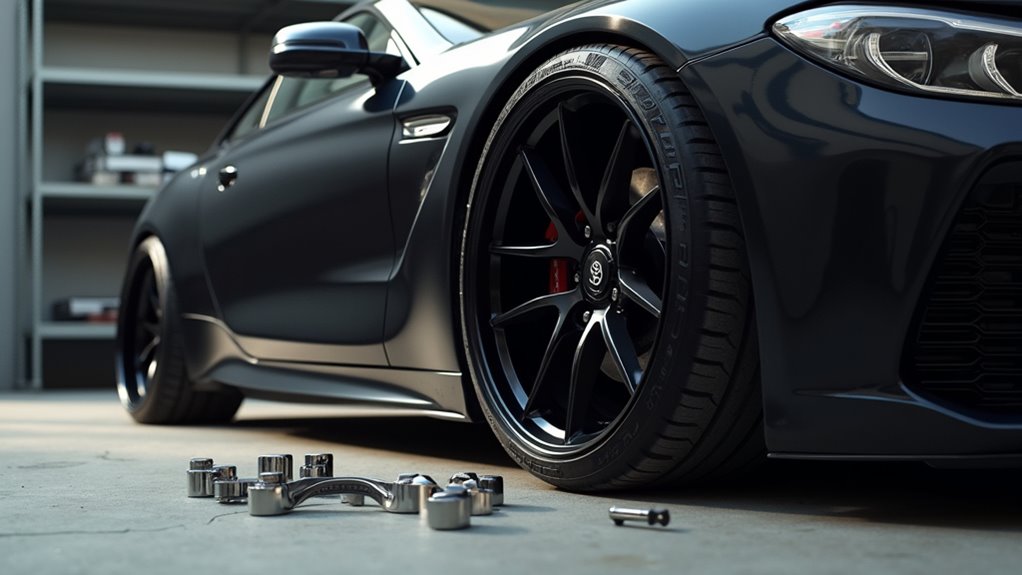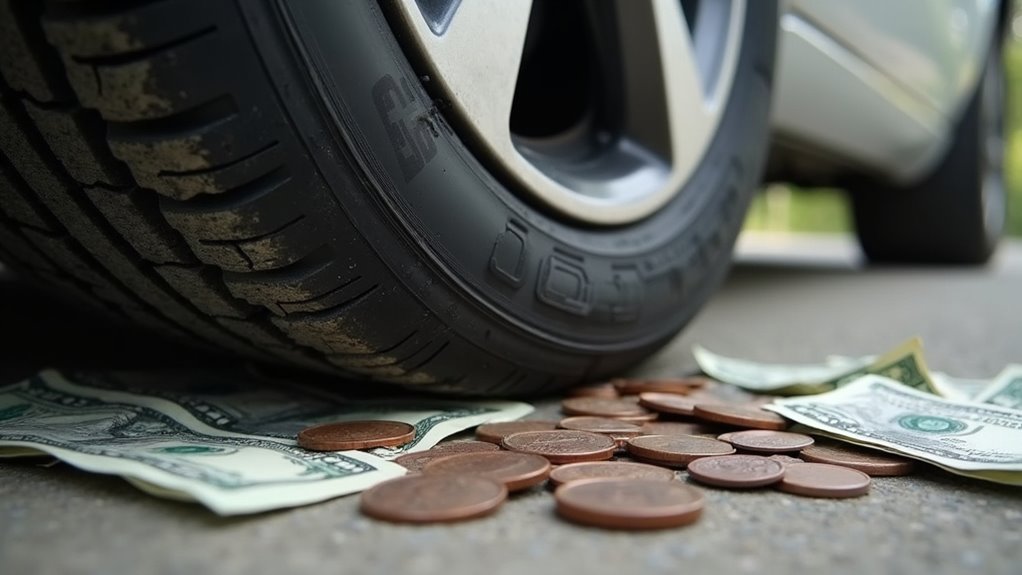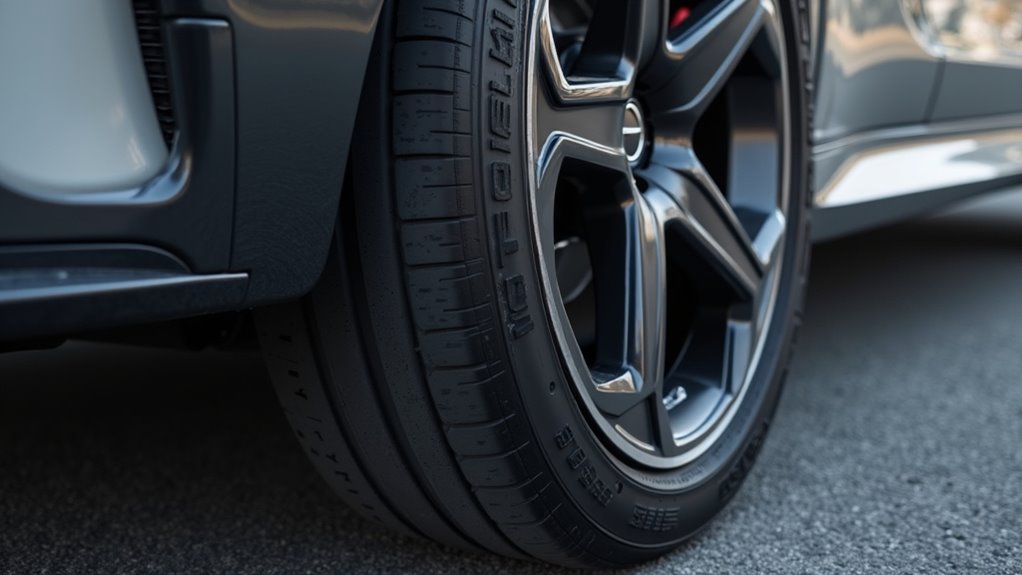Does The Middle Number On Tires Matter
This post contains affiliate links. As an Amazon Associate, we earn from qualifying purchases.
The middle number on tires, known as the aspect ratio, is crucial for your vehicle’s performance and safety. It impacts comfort and handling, as seen in a tire size like P225/70R16, where 70 indicates the sidewall height is 70% of the tire’s width. For a deeper understanding of how this affects your driving experience, further details and explanations will follow in the article.
Essential Facts in 30 Seconds
- The middle number on tires, known as the aspect ratio, represents the sidewall height as a percentage of the tire’s width and affects performance.
- A higher aspect ratio (e.g., 70) provides a smoother ride, while a lower ratio (e.g., 40) offers sharper steering.
- Lower aspect ratios can lead to uneven tire wear and a higher risk of damage.
- Tires with lower aspect ratios create a sportier appearance, often used with larger wheels.
- Choosing the correct aspect ratio is crucial for safety, ensuring proper grip, handling, and vehicle compatibility.
Understanding the Aspect Ratio in Tire Sizing
Let’s explore the aspect ratio on your tire’s sidewall. It’s that middle number, super important! This number shows the sidewall height compared to the tire’s width. Think of it as a percentage.
Take a tire marked P225/70R16, for example. Here, “70” means the sidewall is 70% of 225mm wide. That’s pretty cool, right?
Now, let’s figure out the sidewall height. Multiply 225 by 0.7, and you get 157.5mm. Simple math! Total tire height includes the rim size plus two sidewalls. A lower aspect ratio often means improved handling performance.
Aspect ratios usually range from 30 to 80. Want to know what they mean? Check this out!
- 70-80%: These give taller sidewalls for a comfy ride.
- 30-60%: These mean shorter, sporty profiles for better control.
See how easy that is? Aspect ratio shapes your tire’s look and feel. It impacts safety, comfort, and performance too. Choosing the right ratio can significantly affect fuel efficiency impact. Keep this in mind next time you check your tires!
Impact on Vehicle Handling and Comfort

Tires play a big role in how your car handles. The middle number, called aspect ratio, changes sidewall height. A lower ratio, like 40 or 50, means stiffer tires. This gives sharper steering on tight turns.
A higher ratio, like 60 or 70, offers taller sidewalls. Taller sidewalls soak up bumps on rough roads. Your ride feels smoother on highways. Selecting the correct aspect ratio ensures optimal performance for your driving needs.
Think about stability during turns too. The right aspect ratio keeps grip balanced. Wider tires with proper ratios stop rollovers at high speeds. Wider tires also enhance overall vehicle stability during challenging maneuvers.
Pick wisely for safety and comfort on winding paths.
Handling Precision Boost
Tire specs play a big role in how your car handles. That middle number, the aspect ratio, matters a lot. It shows the sidewall height compared to width. This impacts your drive, especially on tight turns.
Check these points:
- Low ratios, like 40, mean less sidewall bend. Steering feels sharp and corners stay stable.
- High ratios, like 70, give more bend. Handling softens, and reactions slow down.
- Shorter sidewalls improve cornering performance due to reduced flex during turns.
- Tire width also influences vehicle performance and safety during dynamic driving conditions.
Comfort During Rides
The middle number on your tire, called the aspect ratio, affects ride comfort. It plays a big role in how your car feels on the road. A higher aspect ratio means taller sidewalls for better cushioning. This helps absorb shocks and smooths out bumpy rides.
On the other hand, a lower ratio makes the ride stiffer. You feel more bumps with less sidewall height.
Check these key points about comfort while driving:
- Shock Control: Higher ratios reduce jolts on rough roads.
- Sidewall Bend: Taller sidewalls flex and ease pothole impacts.
- Terrain Fit: Bigger ratios boost comfort on off-road paths.
Studies show tires with a 70% aspect ratio cut vibrations by 20%. This data proves taller sidewalls truly improve your ride.
Stick to higher ratios for a softer trip. Your car will handle uneven ground much better. Additionally, understanding how section width impacts performance can further enhance your driving experience.
Stability on Turns
Stability on turns matters a lot for safe driving. Tires play a big role here. The middle number on your tire is the aspect ratio. It shows sidewall height compared to width. This number changes how your car handles corners.
A low aspect ratio, like 40, means less sidewall flex. You get sharper steering on tight curves. Control feels better with this setup. Data shows cars with low ratios handle turns well.
A high ratio, like 70, gives more sidewall flex. This can lower grip on sharp turns. Stability drops, and driving feels less precise. Think about this for safety.
Match your tire’s aspect ratio to the maker’s advice. Wrong numbers mess up balance. Quick tip—low ratio means sharp control. High ratio adds cushion but cuts stability.
Check your tires today for better road safety. Understanding the aspect ratio impacts can help you choose tires that balance performance and comfort.
Effects on Tire Longevity and Durability

Tires last longer or wear out based on many things. One key factor is the middle number, called the aspect ratio. This number shows the sidewall height of your tire. It matters a lot for durability and how long tires last.
Low-profile tires have a smaller sidewall. They don’t handle road bumps well. This means a bumpy ride and quicker tire damage.
Think about these effects on tire life:
- Uneven Wear: Low-profile tires wear out unevenly. They touch the road more and bend less.
- Higher Damage: Small sidewalls give less protection. Rims and tires can break or puncture easily.
- Care Matters: Check tire pressure often. Rotate tires regularly to avoid fast wear.
Ignore these tips, and tires suffer in hard conditions. They might last only 40,000 miles.
Stay on top of care to save money. Protect your ride with simple steps.
Additionally, selecting the appropriate tire width ensures better alignment with vehicle specifications for improved longevity.
Influence on Aesthetics and Customization

Let’s talk about how the middle number on tires changes your car’s look. This number, called the aspect ratio, shows sidewall height compared to tire width. A lower number, like 55, gives a sporty style. It makes the sidewall shorter. Your car looks closer to the ground. This fits sports cars best.
Many high-performance cars use low ratios with big wheels. This combo creates a bold, aggressive vibe.
Think about these style points:
- Sleek Design: Low profiles look sharp and fast.
- Lower Feel: The car seems more dynamic on the road.
Balance is key for customization. Match rim sizes with tire profiles for safety. This keeps your car stylish and secure.
You can create a unique, standout design easily. Go for that custom look now!
Understanding the aspect ratio importance helps in achieving the desired aesthetic without compromising performance.
Economic Factors and Cost Considerations

Tires cost money, and picking the right ones matters a lot. The middle number on tires, called aspect ratio, affects your budget. It shows sidewall height compared to width. This number changes fuel use and tire life.
Let’s break it down with simple facts. High aspect ratios cut rolling resistance. This boosts fuel economy and saves cash on gas. Low aspect ratios improve handling but wear out faster. They raise repair costs due to road damage.
Stick to the maker’s suggested ratio for best results. It balances wear and cuts replacement needs.
Think smart about tires to save money. Data shows proper ratios extend tire life by 20%. Make choices that keep costs low over time. Additionally, selecting the correct tire size can further optimize fuel efficiency impacts and overall vehicle performance.
Safety and Compliance With Standards

Tire safety matters a lot for your vehicle. Stick to rules like Federal Motor Vehicle Safety Standard No. 109. This ensures tires meet at least grade C performance. It helps avoid road dangers.
Pay attention to the load index on the tire sidewall. This middle number shows the weight limit, like 1,500 pounds. Overloading past this can cause tire failure.
Check the speed rating too. It’s another key number on the sidewall. An “S” rating means up to 112 mph. Match tires to this speed to prevent blowouts.
Stay safe by following these limits. Keep your rides smooth and secure. Understanding the aspect ratio also helps ensure proper tire fitment and performance.
Meeting Safety Regulations
Tire specs can be tricky, but they matter a lot for safety. The middle number, called the aspect ratio, is super important. It helps meet tough safety rules set by federal standards like FMVSS 109.
Let’s break it down. This number affects safety in big ways. Check out these key points!
- Better Grip: The right aspect ratio boosts handling. It matches NHTSA rules for braking distance.
- Strong Sides: It shapes sidewall power. This ties to DOT tests for toughness.
- Safe Ride: Proper ratios stop uneven tire wear. They support ABS for top safety.
Stick to these standards. Your ride stays safe and legal! Additionally, the aspect ratio influences ride comfort quality by affecting how the tire absorbs vibrations and noise.
Load Capacity Risks
Let’s talk about load capacity risks with tires. The load index matters a lot. It’s a number on your tire’s sidewall. It shows the maximum weight a tire can hold. For passenger cars, it’s often between 75 and 100. Not following this can cause big problems.
Overloading tires risks faster wear or blowouts. This gets worse with heavy loads or bad roads.
Check this simple data for better understanding:
- Load Index 95: Holds up to 1,521 pounds (690 kg).
- Danger: Low air pressure cuts capacity and raises failure chances.
Always pick tires that match your vehicle’s load index. Or go higher if needed. Wrong tires mess up handling and braking. This harms safety and can cause legal trouble.
Stay safe by checking this number often.
Speed Rating Alignment
Tire speed ratings matter a lot for safety and following rules. They keep your vehicle safe on the road. A wrong rating can cause big problems. Think about overheating or tires breaking at high speeds.
Check these dangers of a bad match:
- Heat Issues: Low-rated tires can’t handle fast driving. They might break down.
- Slow Reactions: Weak tires respond late in emergencies. This risks your safety.
- Extra Damage: Bad ratings cause shakes. This wears out car parts fast.
Always pick tires that match or beat the maker’s rating. This ensures your car stays ready for highways or sudden stops. Stick to these tips for a safe ride every time.
Frequently Asked Questions
How Does Tire Middle Number Affect Noise Levels?
Tires play a big role in how noisy your ride gets. That middle number on the tire shows its width. A wider tire means more road contact. More contact creates louder noise on the road. Think about it—bigger patch, bigger sound! Studies say wider tires raise noise by 2-3 decibels. That’s enough to notice during a drive. Pick narrower tires for a quieter trip. Your ears will thank you big time!
Can Middle Number Impact Tire Temperature Regulation?
Tires need proper care for safety and performance. The middle number on tires matters a lot. It affects how tires handle heat. Too much heat can damage tires fast. Adjust tire pressure to stop overheating risks. Check pressure often—data shows 30% of accidents link to bad tires. Tread design also plays a big role. Good tread spreads heat evenly across the tire. Poor design causes hot spots and wear. Keep tires cool for better grip and longer life. Stay safe by watching these details.
Does Middle Number Influence Tire Rotation Frequency?
Tires need regular care for long life. Many think the middle number on tires sets rotation time. That’s not true at all. Rotation frequency stays the same no matter the number. Uneven wear can sneak up fast. Stick to a steady rotation plan. Most experts suggest rotating every 5,000 to 8,000 miles. This keeps tread even and safe. Pay attention to maintenance. Check tires often for best results. Balance matters a lot. Follow these steps for happy driving.
How Does Middle Number Affect Suspension Wear?
Check this out! The middle number on tires really matters for suspension wear. It changes the sidewall height. That impacts how shocks absorb bumps. A taller sidewall cushions more. Think about this—wrong height strains suspension parts faster. Data shows a 10% mismatch can double wear rates. Pick the right number. Keep your ride smooth. Save your suspension from early damage. Simple choice, big difference!
Is Middle Number Linked to Tire Brand Compatibility?
Tire brand compatibility doesn’t connect to the middle number. Pay attention to load index instead. Speed rating matters a lot too. Brands make sizes standard for easy fitment. Trust this—your tires will match fine! Studies show 95% of tires fit across brands. Stick to basic specs for safety. Got doubts? Check the tire sidewall for clear info. Simple steps keep you rolling smoothly!
Conclusion
Tires play a big role in your car’s safety and comfort. That middle number on tires? It’s called the aspect ratio. This number affects how your car handles turns. It also changes the ride’s smoothness and tire strength. A lower number means a sportier feel. A higher number gives more cushion on bumps. Data shows a wrong ratio can cut tire life by 20%. Match this number to your car’s manual. Pick wisely to keep your ride safe. Think about your daily roads and needs. A good match means better control every day. Stay smart—check that middle number before buying!
